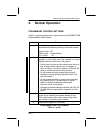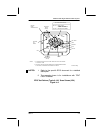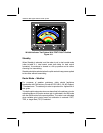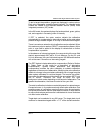
PRIMUS
r
880
Digital
W
eather
Radar
System
A28-1146-102-00
Normal Operation
4-6
Radar Mode - Ground Mapping
NOTE: Refer to Tilt Management in Section 5, Radar Facts, for
additional information on the use of tilt control.
Ground-mapping operation is selected by setting the controls
to GMAP. The TILT control is turned down until a usable amount of
navigable terrain is displayed. The degree of down-tilt depends on the
aircraft altitude and the selected range.
The receiver STC characteristics are altered to equalize ground-target
reflection versus range. As a result, selecting preset GAIN generally
creates the desired mapping display. However, the pilot can controlthe
gain manually (by selecting manual gain and rotating the GAIN control)
to help achieve an optimum display.
With experience, the pilot can interpret the color display patterns that
indicate water regions, coast lines, hilly or mountainous regions, cities,
or even large structures. A good learning method is to practice
ground-mapping during flights inclear visibility wherethe radar display
can be visually compared with the terrain.
TEST MODE
The PRIMUS
â
880 Digital Weather Radar System has a self-testmode
and a maintenance function.
In the self-test (TST) mode a special test pattern is displayed as
illustrated earlier in this section. The functions of this pattern are as
follows:
D Color Bands - A series of green/yellow/red/magenta/white bands,
indicate that the signal to color conversion circuits are operating
normally.
The maintenance function lets the pilot or the line maintenance
technician determine the major fault areas. The fault data can be
displayed in one of two ways (selected at the time of installation):
D TEXT FAULT - A plain English text indicating the failure is placed
in the test band.
D Fault code - A fault code is displayed, refer to the maintenance
manual for an explanation.
The indicator or EFIS display indicates a fault as noted below.
D Dedicated Radar Indicator - A FAIL annunciation is shown at the
top left corner of the test pattern. It indicates that the built-in test
equipment (BITE) circuitry is detecting a malfunction. The exact
nature of the malfunction can be seen by selecting TEST. (Refer to
Section 7, In-Flight Troubleshooting.)


















